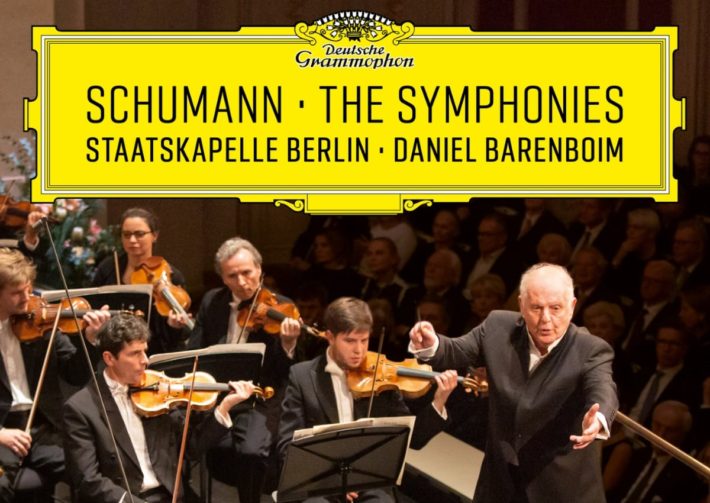This is Barenboim’s third set of Schumann symphonies. The first was recorded in the late 1970s with the Chicago Symphony Orchestra when he was their principal guest conductor. The next set, recorded by Teldec (now Warner Classics) was with the Staatskapelle Berlin, their sumptuous autumnal colorings a stark contrast to the brighter and leaner colors of Chicago. In both Barenboim’s interpretative vision is mostly consistent, though he allows greater freedom to shape phrases and manipulate tempos in Berlin. The Chicago performances feature sharp initial attacks and a more heterogenous sound, the brass sometimes dominating the orchestral timbre. But in Berlin attacks are more rounded and the orchestral playing features richer strings and darker hues, beautifully caught by the Teldec engineers. Those same qualities are heard in this new set, recorded live last year, but DG’s engineering has greater transparency, the orchestral sound less reverberant (and the timpani less in-your-face, the only balance issue in the previous recording). In all three cycles, Barenboim masterfully clarifies textures (in both Berlin sets violins are on his right and left), proving that Schumann’s orchestration is wonderfully effective when tended to with care.
Barenboim’s admiration of Wilhelm Furtwängler and Sergiu Celibidache has perhaps led him to embrace the continuous legato, generous rubato, and freedom of pulse that was a facet of both conductor’s style. These interpretative ideals are readily apparent in Barenboim’s performance of the first symphony. The opening fanfare lacks rhythmic definition, with overly smooth phrasing. Throughout the opening movement the tempo is pushed and pulled about – listen to the meal made of the brass fanfares at 6’48”, and at how strongly Barenboim pulls back the tempo at 9’08”. If there are rhetorical reasons for these moments it is lost on me, but in both instances the energy quickly dissipates.
The slow movement offers playing of great refinement and beauty, while the scherzo has a weightiness more appropriate for Bruckner or Mahler, the sustained legato reminiscent of Karajan’s reading with the ‘other’ Berlin orchestra. The horn calls in the fourth movement (3’38”) are undeniably magical, a lovely oasis in the midst of the music’s robust writing. Ultimately, the reading feels like a journey in which Barenboim slows down to show us specific moments he finds particularly captivating, thereby negating a sense of the music’s architecture and musical line.
The reading of the second symphony could not be a greater contrast: the opening movement’s slow introduction is masterfully shaped, leading into an excitingly driven Allegro. Barenboim avoids any sudden changes in tempo, and his phrasing really breathes. Although I would have liked more wind color at 6’15”, hearing the lower strings really dig into their ascending lines at 6’35” is thrilling. By conveying the music’s structure without any unnecessary tempo modifications, the music’s energy continually builds so that the repeating ‘obsession’ motive in the recapitulation has alarming emotional desperation.
Related Posts
- Review: Schumann – Complete Symphonies – Pablo Heras-Casado, Münchner Philharmoniker
- Review: Brahms Complete Symphonies – Berlin staatskapelle, Daniel Barenboim
- Review: Schumann – Symphonies Nos. 1 & 2 (Re-orchestrated by Mahler) – Alsop
The scherzo, too, is powerful, Barenboim’s orchestra following him every step of the way. Both trios are lovingly shaped, and the string playing in the coda (played at a whiplash tempo) is exhilaratingly dispatched. In the Adagio the Staatskapelle solo winds are fulsome yet tender, the strings richly lyrical. The last movement is again energetic and driven, sound transparent yet weighty, the music’s celebratory ending emotionally satisfying. This is the strongest performance in the set.
The third symphony gets off to a electrifying start, the horns clearly enjoying themselves. But Barenboim returns to making unexpected (and unmarked) tempo changes, resulting in a loss of energy and structural cohesion. There is no denying the brilliance of the orchestral playing, though the brass, rather unexpectedly, are reined in in the movement’s final bars.
The inner movement also lack energy, or is it perhaps that the seamless legato wears thin? Sawallisch’s classic Dresden recording is even slower, yet he finds greater light and shade in the Scherzo, and there is a beguiling delicacy to the third movement in Heras-Casado’s recent Munich recording for Harmonia Mundi (reviewed here). The fourth movement has a potent atmosphere of almost Wagnerian weight, but the last movement seems under characterized, at least until the final brass perforation.
The fourth’s opening movement lacks forward momentum when compared to Karajan and Sawallisch. I sampled Furtwängler’s 1953 Berlin performance (DG) and one can hear similarities in interpretative approach between it and Barenboim’s reading. But Furtwängler’s interpretation has an organic inevitability that Barenboim does not conjure. The slow movement’s seamless legato lacking the inner tension that Karajan instilled in his phrasing. The Scherzo is strongly rustic, though its weight seems more appropriate to Bruckner, and the tempo changes between the scherzo and trios is too extreme. The final movement’s opening is an improvement on the previous cycle, where Barenboim’s introductory Adagio takes a distended 1’43”, while in the new recording he takes only 1’27”. And the Presto that follows has the same propulsive energy heard in the second symphony.
Barenboim’s interpretations are certainly out of step with the more recent performances on historical instruments, as well as those that reflect historically informed performance practice (such as BPO/Rattle, LSO/Gardiner, and Munich/Heras-Casado). Yet there is a great deal to admire in Barenboim’s approach, and there are certainly some readers who want to hear music from the Romantic period interpreted with this kind of flexibility and richly upholstered sound. Certainly, I urge everyone to hear the performance of the second symphony.

Schumann – The Symphonies
Staatskapelle Berlin
Daniel Barenboim – Conductor
Deutsche Grammophon, CD 4862958
Recommended Comparisons
Karajan | Sawallisch | Szell | Barenboim 2002
Read more classical music reviews or visit The Classic Review Amazon store
Follow Us and Comment:
Get our periodic classical music newsletter with our recent reviews, news and beginners guides.
We respect your privacy.









